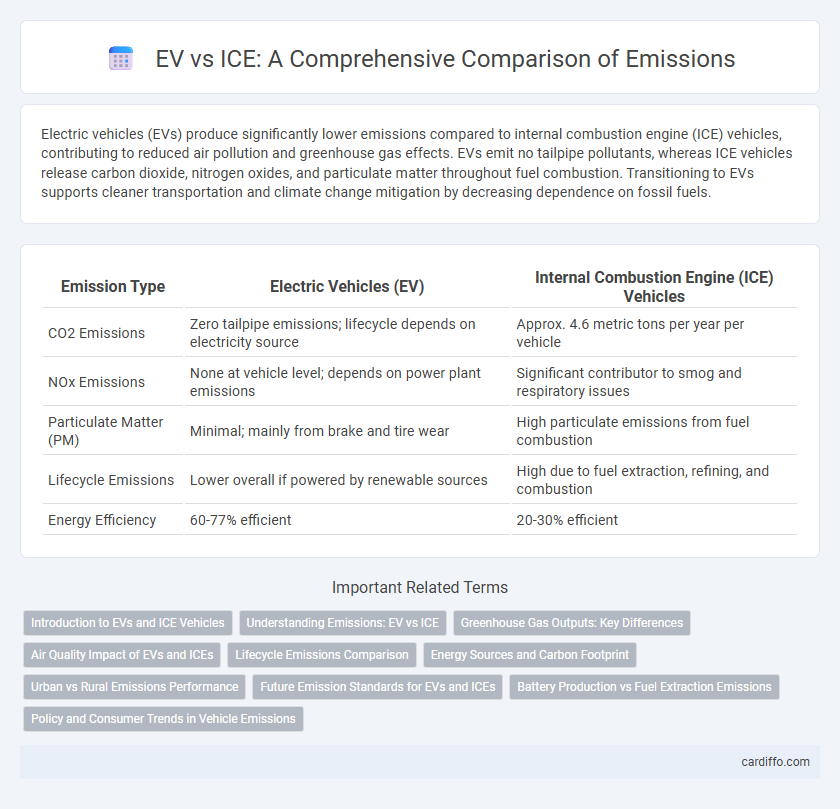Electric vehicles (EVs) produce significantly lower emissions compared to internal combustion engine (ICE) vehicles, contributing to reduced air pollution and greenhouse gas effects. EVs emit no tailpipe pollutants, whereas ICE vehicles release carbon dioxide, nitrogen oxides, and particulate matter throughout fuel combustion. Transitioning to EVs supports cleaner transportation and climate change mitigation by decreasing dependence on fossil fuels.
Table of Comparison
| Emission Type | Electric Vehicles (EV) | Internal Combustion Engine (ICE) Vehicles |
|---|---|---|
| CO2 Emissions | Zero tailpipe emissions; lifecycle depends on electricity source | Approx. 4.6 metric tons per year per vehicle |
| NOx Emissions | None at vehicle level; depends on power plant emissions | Significant contributor to smog and respiratory issues |
| Particulate Matter (PM) | Minimal; mainly from brake and tire wear | High particulate emissions from fuel combustion |
| Lifecycle Emissions | Lower overall if powered by renewable sources | High due to fuel extraction, refining, and combustion |
| Energy Efficiency | 60-77% efficient | 20-30% efficient |
Introduction to EVs and ICE Vehicles
Electric vehicles (EVs) produce zero tailpipe emissions, significantly reducing air pollutants compared to internal combustion engine (ICE) vehicles, which emit carbon dioxide (CO2), nitrogen oxides (NOx), and particulate matter (PM) through fuel combustion. EVs rely on electricity stored in batteries, enabling them to operate without burning fossil fuels, while ICE vehicles depend on gasoline or diesel, contributing to greenhouse gas accumulation and climate change. The shift to EVs supports emission reduction goals, improves air quality, and decreases dependence on oil resources.
Understanding Emissions: EV vs ICE
Electric vehicles (EVs) produce zero tailpipe emissions, significantly reducing urban air pollutants such as nitrogen oxides (NOx) and particulate matter compared to internal combustion engine (ICE) vehicles. Life cycle emissions for EVs depend on electricity generation sources; renewable energy integration can substantially lower their carbon footprint, whereas ICE vehicles consistently emit greenhouse gases (GHGs) from fuel combustion. Understanding these differences highlights the potential of EVs to decarbonize transportation and improve air quality when paired with clean energy infrastructure.
Greenhouse Gas Outputs: Key Differences
Electric vehicles (EVs) produce significantly lower greenhouse gas (GHG) emissions compared to internal combustion engine (ICE) vehicles, primarily due to their zero tailpipe emissions. Lifecycle analysis reveals that EVs emit fewer total GHGs when electricity generation is based on renewables or low-carbon sources, whereas ICE vehicles rely heavily on fossil fuels, resulting in higher carbon dioxide (CO2) and methane (CH4) outputs. Studies from organizations like the EPA and ICCT consistently show that EVs reduce overall carbon footprints by 40-70% depending on energy mix and vehicle efficiency.
Air Quality Impact of EVs and ICEs
Electric vehicles (EVs) produce zero tailpipe emissions, significantly reducing particulate matter, nitrogen oxides (NOx), and volatile organic compounds (VOCs) that contribute to urban air pollution and respiratory diseases. Internal combustion engine (ICE) vehicles emit high levels of pollutants, including carbon monoxide (CO) and hydrocarbons, worsening smog and decreasing air quality. Studies show that widespread adoption of EVs can lower ambient pollution levels, improving public health and mitigating environmental damage.
Lifecycle Emissions Comparison
Electric vehicles (EVs) typically produce 40-70% fewer lifecycle greenhouse gas emissions compared to internal combustion engine (ICE) vehicles, considering production, operation, and disposal phases. Battery production for EVs generates higher initial emissions, but lower tailpipe emissions and increased use of renewable energy significantly reduce overall carbon footprint. Lifecycle assessments show that EVs contribute substantially less to air pollution and climate change over their operational lifespan than ICE vehicles.
Energy Sources and Carbon Footprint
Electric vehicles (EVs) powered by renewable energy sources, such as solar and wind, generate significantly lower carbon footprints than internal combustion engine (ICE) vehicles reliant on fossil fuels like gasoline and diesel. Lifecycle emissions analysis reveals that EVs produce fewer greenhouse gases throughout manufacturing, operation, and disposal phases, mainly due to cleaner electricity grids. Transitioning to EVs combined with decarbonized energy infrastructure is crucial for reducing global carbon emissions and mitigating climate change.
Urban vs Rural Emissions Performance
Electric vehicles (EVs) produce significantly lower emissions than internal combustion engine (ICE) vehicles in urban areas due to reduced tailpipe pollutants and regenerative braking systems that improve efficiency in stop-and-go traffic. However, in rural regions where electricity generation often relies on fossil fuels and driving conditions involve longer distances with fewer stops, ICE vehicles may exhibit comparable or lower overall emissions depending on the local energy mix and fuel economy. Lifecycle assessments emphasize the urban advantage of EVs in cutting greenhouse gases and particulate matter, while rural emission benefits depend heavily on grid decarbonization and vehicle usage patterns.
Future Emission Standards for EVs and ICEs
Future emission standards for electric vehicles (EVs) and internal combustion engine (ICE) vehicles are tightening globally to reduce greenhouse gas emissions and air pollutants. Regulations such as the Euro 7 standard and California's Advanced Clean Cars program impose stricter limits on tailpipe emissions for ICE vehicles while also setting requirements for EV battery lifecycle emissions and charging infrastructure sustainability. These evolving standards aim to accelerate the transition to zero-emission EVs by 2035, encouraging cleaner manufacturing processes and promoting renewable energy integration.
Battery Production vs Fuel Extraction Emissions
Battery production for electric vehicles (EVs) generates significant emissions primarily due to mining and processing of lithium, cobalt, and nickel, contributing roughly 30-40% of an EV's total lifetime emissions. In contrast, internal combustion engine (ICE) vehicles incur greater emissions from continuous fuel extraction, refining, and combustion throughout their operational life, accounting for over 70% of total vehicle emissions. Despite higher initial emissions from battery manufacturing, EVs achieve lower overall carbon footprints by eliminating fuel combustion emissions during use.
Policy and Consumer Trends in Vehicle Emissions
Policies increasingly favor electric vehicles (EVs) through stricter emission regulations and incentives, accelerating the shift away from internal combustion engines (ICE). Consumer trends show growing preference for EVs driven by environmental awareness, lower operational costs, and expanding charging infrastructure. Governments worldwide implement zero-emission mandates and tax benefits, reinforcing market transformation towards sustainable transportation.
EV vs ICE Infographic

 cardiffo.com
cardiffo.com